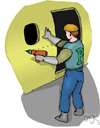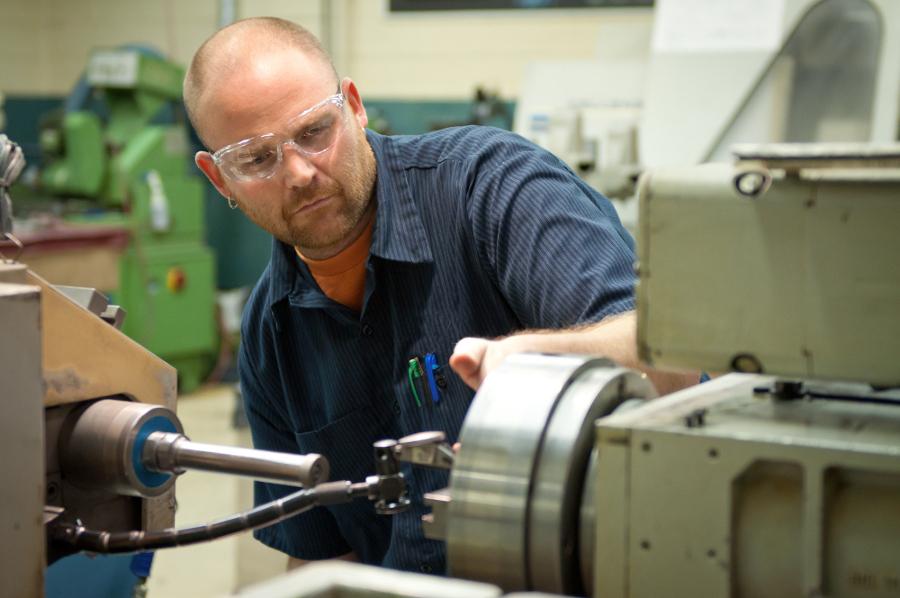Bim To Gifts For Fabricator For Conceptual Design
by Peter
Posted on 12-08-2020 05:16 AM

Digital fabrication for architectural design is the process of using computer controlled machines for manufacturing physical objects by leveraging the geometrical output from a 3d bim model. In this project we will explore cnc manufacturing, laser cutting, and 3d printing as an integrated part of the design process.

Digital fabrication enhances design insight and design communication. The best way to begin learning the toolsets inherent to digital fabrication is to begin small, integrating model making as part of a design process while understanding its potential for scalable constructs. In this project you will build a conceptual design for a small museum while connecting a bim model to fabrication processes designed to drive cnc routers, laser cutters, and 3d printers. To learn more about the bim to fabrication process, you can read david beach's blog , or watch a recording of his on air webinar.
Construct Your Industry Network
Steel sections and plates are generally manufactured to bs en 10025-2 for open sections, bs en 10210-1 for hot-finished tubes , and bs en 10219-1 for cold-formed hollow sections.
![]() All sections are accompanied by type 3. 1, product specific ce inspection documents. Large orders can be supplied direct from the steel mills, but steelwork contractors normally obtain their steel sections and plates from a steel stockholder. Steel stockholders play a vital part in the steel construction supply chain, ensuring that the market is supplied with what it needs when it is needed. The industry has an extensive network of depots serving all parts of the country. The stockholders provide a range of products to the construction industry including heavy structural sections , plates , light sections , cladding materials, flats, angles. Total stocks held represent about 40 days supply. All bcsa stockholder members have quality management systems such as bs en iso 9001 in place supplemented by individual identification systems to ensure full traceability from the steel manufacturer to the steelwork contractor. The specification and quality controls placed on stockholders by the bcsa ‘model specification for the purchase of steel sections and plates’ ensures the quality of steel sections and plate placed on the uk market by bcsa stockholders.
All sections are accompanied by type 3. 1, product specific ce inspection documents. Large orders can be supplied direct from the steel mills, but steelwork contractors normally obtain their steel sections and plates from a steel stockholder. Steel stockholders play a vital part in the steel construction supply chain, ensuring that the market is supplied with what it needs when it is needed. The industry has an extensive network of depots serving all parts of the country. The stockholders provide a range of products to the construction industry including heavy structural sections , plates , light sections , cladding materials, flats, angles. Total stocks held represent about 40 days supply. All bcsa stockholder members have quality management systems such as bs en iso 9001 in place supplemented by individual identification systems to ensure full traceability from the steel manufacturer to the steelwork contractor. The specification and quality controls placed on stockholders by the bcsa ‘model specification for the purchase of steel sections and plates’ ensures the quality of steel sections and plate placed on the uk market by bcsa stockholders.
Field Fabrication of Piping spools
The key to the success of whole project!
industrial construction includes a wide range of projects, such as petroleum refineries and chemical and power plants.
 This type of construction involves intensive piping, which connects a variety of equipments and conveys process fluid and gas. Due to compressed schedule and limited space on site, industrial construction projects rely heavily on the offsite fabrication and assembly. As such, piping work is divided into two stages: pre-fabrication of pipe spools and site installation.
This type of construction involves intensive piping, which connects a variety of equipments and conveys process fluid and gas. Due to compressed schedule and limited space on site, industrial construction projects rely heavily on the offsite fabrication and assembly. As such, piping work is divided into two stages: pre-fabrication of pipe spools and site installation.
Pros and Cons of Field fabrication
Here we focus on the technology of biofabrication that uses cells and materials as building blocks, and which is mainly used for te and rm applications. Our objective is to summarize, specify and classify the rapidly growing and diverging biofabrication research activities in the field. The use of printing technologies for 3d positioning of cells was first demonstrated in 1988 by klebe under the term cytoscribing [ 11 ]. Despite the truly pioneering character of this work and possibly because there was a long interval before researchers returned to the concept, this term was not picked up by the subsequent literature. The term 'organ printing', on the other hand, first appeared in 2003 and was defined as 'a rapid prototyping computer-aided 3d printing technology, based on using layer-by-layer deposition of cells and/or cell aggregates into a 3d gel with sequential maturation of the printed construct into perfused and vascularized living tissue or organs' [ 12 ]. 'organ printing' is still frequently used, particularly in the popular literature, however its current usage is often broader than this quite narrow original definition.
The historical evolution of the term biofabrication, when used in the field of te and rm, has occurred in parallel with the evolution of the term bioprinting and possibly this has led to a confusion and possible conflation of the two terms, especially in the popular and journalistic media. Bioprinting was, to the best of our knowledge, first used as a term in the title of the 'workshop on bioprinting, biopatterning and bioassembly' held at the university of manchester, uk, in 2004. In a report on this meeting mironov, reis and derby stated: 'for the purpose of the meeting, bioprinting was defined as: the use of material transfer processes for patterning and assembling biologically relevant materials—molecules, cells, tissues, and biodegradable biomaterials—with a prescribed organization to accomplish one or more biological functions' [ 13 ]. The term bioprinting was subsequently used to specifically describe a process where a mechanical fabrication tool is used to organize or pattern biological entities in two- or three-dimensions to build an artificial construct [ 14 ]. In 2010 guillemot et al defined bioprinting as 'the use of computer-aided transfer processes for patterning and assembling living and non-living materials with a prescribed 2d or 3d organization in order to produce bio-engineered structures serving in regenerative medicine, pharmacokinetic and basic cell biology studies' [ 15 ]. It is thus clearly related to the parallel development of additive manufacturing that was then emerging as an engineering fabrication tool. Consequently, biofabrication was first defined by mironov et al in the inaugural issue of the journal biofabrication in 2009 as 'the production of complex living and non-living biological products from raw materials such as living cells, molecules, extracellular matrices, and biomaterials' [ 16 ].
It is evident that the terms bioprinting and biofabrication are closely related, and since their respective existing definitions overlap, it is extremely difficult to effectively differentiate them. As a consequence, they are often used inconsistently or interchangeably, which underscores the need for clarification. As recently pointed out by hutmacher and colleagues [ 17 , 18 ], it would be beneficial for a new astm/iso norm to be developed, or for a new sub-norm to be defined under astm f2792 in order to unambiguously define the terms biofabrication and bioprinting. Beyond this more technical approach, and as already suggested by boland and mironov [ 19 ], we believe that determining the positioning of biofabrication as a research field and its relationship with te and rm will help in clarifying these definitions.
Whether you are a potential client, who has questions about metal fabrication, welding services, or other related skills, or someone who is considering entering the field as a professional, here are some of the more common terms you may come across. 1. Punching this is the process of forming metal components with a punch machine. This device has mounted the slide or in a die set for alignment, but only when inside the inverted die.
16 sep 2013 the term modular fabrication is commonly applied to materials and equipment built for use in the oil and gas industry. However, some people may be unaware of exactly what the term refers to and what advantages it offers over traditional, in-field construction. This article will briefly examine what modular fabrication is and what benefits it offers.
Modular fabrication refers to the process of building and constructing equipment off-site in a fabrication facility. The completed product can then be delivered to the worksite and quickly installed and integrated into field operations. This differs from on-site construction in which the equipment or system is fully built at the worksite. Modular fabrication offers another set of very significant benefits over field construction: efficiency, speed, safety, quality, economy, and convenience.
Shop fabrication and install
The installation of pipe systems follows its fabrication and is very frequently a part of it. The installation of pipe can be accomplished in the following two primary ways, or combinations thereof: field fabricate and install shop fabricate and field erected some contractors prefer to do most, if not all fabrication in the shop, others prefer to set up at the job-site, while others are flexible enough to utilize the best of both methods.
Shop fabrication is, generally speaking, any pipe, fittings and components that are assembled by welding into spool assemblies at the present for fabricator mug for a fabricator gift for a fabricator 's facility. The spools are then labeled with an identifier and transported to the job site for installation. Each spool piece needs its own identifier marked on the piece itself in some fashion that will make it easy to know where its destination is in the facility and/or where it belongs in a multi-spool system of pipe. This will allow the installer to efficiently stage the piece and ready it for installation.
About Opendesk — what is digital fabrication?
There are a huge range of digital fabrication techniques. The important aspect that unifies them is that the machines can reliably be programmed to make consistent products from digital designs. This means that an opendesk design can be downloaded and made, reliably and repeatably, all over the world, without a maker needing to have specialist equipment.
Job Description for a Fabrication Engineer
Metal fabrication is the creation of metal structures by cutting, bending and assembling processes. It is a value-added process involving the creation of machines, parts, and structures from various raw materials. Typically, a fabrication shop bids on a job, usually based on engineering drawings , and if awarded the contract, builds the product. Large fab shops employ a multitude of value-added processes, including welding, cutting, forming and machining.
Metal fabrication refers to the building of metal structures by assembling, bending, and cutting processes. It is a value-added process that involves creating machines, parts, and structures from raw materials. A value-added process is one that adds value to a product and for which customers are willing to pay. Fab shops bid on jobs, which are usually based on engineering drawings. If they win the contract, it means they build the product.
Metal fabrication is the creation of metal structures by cutting, bending and assembling processes. It is a value-added process involving the creation of machines, parts, and structures from various raw materials. Typically, a fabrication shop bids on a job, usually based on engineering drawings, and if awarded the contract, builds the product. Large fab shops employ a multitude of value-added processes, including welding, cutting, forming and machining.
Spinning solution flow model in the nozzle and experimental study of nanofibers fabrication via high speed centrifugal spinning
Comparing with traditional methods, high speed centrifugal spinning has the advantages of simple fabrication principle and high preparation efficiency. In this study, the flow law of spinning solution in the nozzle and the effect of spinning parameters on the morphology of nanofibers were explored. A motion model of spinning solution in the nozzle was established to study the velocity distribution of spinning solution in the nozzle, moreover, the relationship between the critical rotational speed required to form the jet and the spinning parameters was studied. It was found that the current velocity of spinning solution was mainly concentrated at the axis of the nozzle and shifted in the direction of coriolis acceleration. The relationship between spinning parameters and the critical rotational speed was verified. The critical rotational speed for forming the spinning jet was directly proportional to the spinning solution concentration and inversely proportional to the nozzle diameter. Polyoxyethylene (peo) nanofibers were fabricated by selectively adjusting spinning parameters and characterized by using scanning electron microscopy (sem). The results showed that the diameter distribution of nanofibers could be adjusted by changing the spinning parameters, such as spinning solution concentration, rotational speed, nozzle length, nozzle diameter and collection distance. The high speed centrifugal spinning has the potential to produce single continuous nanofibers efficiently.
Semiconductor Fabrication Material Market 2020 Industry Analysis, Forthcoming Growth, Industry Prospects and Forecast to 2026
Semiconductor fabrication material market provides detailed analysis of market overview, drivers, prospects, potential application. Also semiconductor fabrication material industry research report includes the future impact of major drivers and challenges and, support decision makers in manufacture cost-effective professional decisions. Semiconductor fabrication materials can be defined as materials used to pattern the wafer of the semiconductor. The semiconductor fabrication process is used for the creation of integrated circuits on the semiconductor. Electric current is transferred through these integrated circuits. On the other hand, materials used to protect and/or connect the die are called packing materials. It moreover discussions about the semiconductor fabrication material market size of different sections and their growth aspects along with growth trends, various investors, business leader, dealers, sellers, study and media,swot analysis.
NFPA 318: Standard for the Protection of Semiconductor Fabrication Facilities
Description improve chemical safety and emergency response using the 2018 edition of nfpa 318: standard for the protection of semiconductor fabrication facilities. The semiconductor industry continues to advance, requiring new safeguards to address evolving hazards. Reorganized and with major revisions to the requirements for both gas-detection systems as well as smoke detection systems, nfpa 318: standard for the protection of semiconductor fabrication facilities applies to semiconductor fabrication facilities and comparable r&d areas in which hazardous chemicals are used, stored, and handled -- containing a cleanroom or clean zone or both.
» chapter 5703-9 sales and use tax 5703-9-20 sales and use tax; production or fabrication of tangible personal property. Production or fabrication of tangible personal property for a consideration is included in the definition of "sale" and "selling," as defined in division (b) of section 5739. 01 of the revised code, whether all or a portion of the materials are supplied by the person performing.
Search
Categories
- Songwriter
- Resident Care
- Retirement
- Runner
- Sailor
- Helmsman
- Grammar Police
- Flight Attendant
- Fisher
- Entertainer
- Editor
- Daily Nutritinionist Facts
- Cyber Security
- Crusader
- Criminology
- Coworker
- Clinical Specialist
- Clinical
- Optometrist
- Logistician
- Magistrate
- Manicurist
- Marines
- Marketer
- Occupation
- Observer
- Officer
- Oncologist
- Painter
- Lifeguard
- Infopreneur
- Nanny
- Cartographer
- Expediter
- ESL Teacher
- Comedian
- Estimator
- Flagger
- Discjokey
- Driving
- Electrologist
- Fumigator
- Erector
- Driller
- Educator
- Dressmaker
- Forensic
- Legislator
- Harvester
- Cooker
- Inspector
- Hacker
- Civil Law
- Employer
- Enologist
- Endocrinologist
- Freelancer
- Enrobing
- Fabricator
- Forecaster
- Clown
- Criminologist
- Collector
- Docent
- Concierge
- Conservator
- Digger
- Dishwasher
- Drafter
- Donor
- Controller
- Communication
- Compounder
- Civil
- Clone
- Doctor
- Cinematographer
- Chiropractor
- Rugger
- Bailbondsman
- Jailer
- Deckhand
- Bellman
- Social Worker
- Babysitter
- Reporter
- Trainer
- Agent
- Embroiderer
- Sociologist
- Pharmacist
- Paramedic
- Insurance
- Teller
- Actuary
- Bailiff
- Coordinator
- Carpenter
- Cleaner
- Academic Dean
- Judge
- Boilermaker
- Clerk
- Apprentice
- Secretary
- Author
- Embalmer
- Hiker
- Cooking
- Deputy Sheriff
- Landscaper
- Photographer
- Pediatrician
- Pilot
- Teacher
- Archivist
- Toolmaker
- Singer
- Racer
- Accounting
- Mentor
- Vice President
- Detective
- Waiter
- Florist
- Broker
- Consultant
- Geographer
- Adjuster
- Auctioneer
- Researcher
- Cardiologist
- Marketing
- Interviewer
- Custodian
- Curator
- Caretaker
- Butcher
- Martial Arts
- Ghostbuster
- Mayor
- Machinist
- Innkeeper
- Mediator
- Conductor
- Demonstrator
- Programmer
- Cabinet Maker
- Planner
- Patient
- Copywriter
- Mechanic
- Surfer
- Employee
- Tour Guide
- Fisherman
- Surveyor
- Manager
- Supervisor
- Appraiser
- Police
- Filmmaker
- Woodworker
- Lecturer
- Inventor
- Liaison Officer
- Laborer
- Translator
- Janitor
- Tailor
- Debater
- Climber
- Politician
- Journalist
- Dietitian
- Firefighter
- Adjudicator
- Producer
- Housekeeper
- Entrepreneur
- Bartender
- Barista
- Hairstylist
- Banker
- Baker
- Electrician
- Therapist
- Astronaut
- Professor
- Architect
- Announcer
- Veterinarian
- Scientist
- Investigator
- Dispatcher
- Creative Writing
- Engineer
- Librarian
- Wanker
- Psychology
- Lieutenant
- Realtor
- Pastor
- Biker
- Nutrition
- Dancer
- Musician
- Gardener
- Farmer
- Counselor
- Boss
- Director
- Dentist
- Lawyer
- Nurse
- Accountant
- Coach
- Advisor
- Beekeeper
- Administrator